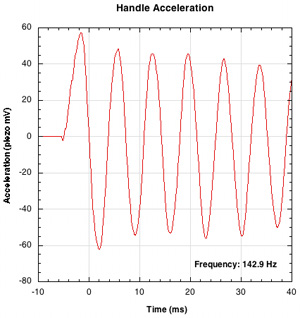
Close Window
When a ball hits a racquet, the racquet bends. The elastic force force acts to restore the bent racquet to its original position. But in doing so, the racquet builds up momentum and overshoots its startng position. This action continues back and forth and is what we know as vibration. The vibration will continue until the racquet loses energy through internal friction and the damping effect of squashing into the hand.
 Vibration is a wonderful indicator of dynamic racquet stiffness. The usual stiffness measurement is performed while supporting the racquet at the handle and in the throat while a force is applied to the tip. The stiffness index is a measurement of how much the racquet tip is deflected. This is a static measurement (performed over a much longer time than the impact of a ball) and depends only on the intrinsic forces holding the racquet together and is what we commonly refer to as static racquet stiffness. However, when the ball impacts the racquet it is a dynamic, instantaneous event, and the amount of racquet deflection depends on both its stiffness (elastic restorative force) and mass distribution. Bending is directly proportional to the degree of stiffness, for the obvious reason that stiffness is, by definition, resistance to bending. And bending depends inversely on mass because a heavy mass is more difficult to accelerate (and decelerate) into bending motion than is a lighter mass.
Vibration is a wonderful indicator of dynamic racquet stiffness. The usual stiffness measurement is performed while supporting the racquet at the handle and in the throat while a force is applied to the tip. The stiffness index is a measurement of how much the racquet tip is deflected. This is a static measurement (performed over a much longer time than the impact of a ball) and depends only on the intrinsic forces holding the racquet together and is what we commonly refer to as static racquet stiffness. However, when the ball impacts the racquet it is a dynamic, instantaneous event, and the amount of racquet deflection depends on both its stiffness (elastic restorative force) and mass distribution. Bending is directly proportional to the degree of stiffness, for the obvious reason that stiffness is, by definition, resistance to bending. And bending depends inversely on mass because a heavy mass is more difficult to accelerate (and decelerate) into bending motion than is a lighter mass.
The combined influence of stiffness and mass is measured by the racquet's vibration frequency. This is the number of back-and-forth cycles that the racquet completes in one second. Frequency is measured in Hertz (Hz), where 1 Hz = 1 cycle per second. The time it takes for one back-and-forth (one cycle or one oscillation) is known as the period of the vibration. And the maximum distance a point on the racquet travels back-and-forth from its equilibrium positon is the amplitude of the vibration.
The stiffer and lighter the racquet, the greater (faster) the frequency, shorter the period, and less the amplitude. And the softer and heavier the racquet, the slower the frequency, the longer the period and the greater the amplitude. Every other combination falls somewhere inbetween.
The vibration frequency is the same no matter where the ball strikes on the stringbed, with the exception of one point (to be explained shortly). However, the amplitude changes considerably depending on impact location. The amplitude of each vibration is greatest for impacts near the tip and throat. It is least just below the center of the racquet head, and in fact becomes zero at the location known as the vibration node, or vibration sweetspot. If you hit this point, the racquet will not bend. This can be visualized easily like this: when you hit close to the tip, the tip bends backward; when you hit close to the throat, the tip bends forward; when you hit right at the spot where the motion changes from backward to forward, the tip won't move at all. That location is the vibration node.
The graph above is a measurement of the acceleration of a racquet's handle at a location 10 cm (about 4 inches) from the butt end resulting from an impact at 25 inches from the handle butt. This graph shows the acceleration of this spot as it changes its motion back and forth. We measure freely suspended racquets, so there is no hand to dampen vibrations in these graphs. The first peak is the combined shock and vibration. It is the motion of the handle resulting from the racquet's backward recoil, backward tip rotation (and forward handle rotation), and bending. This is the initial shock. The peaks after the shock are just the racquet vibrations (bendings back-and-forth).
What you feel (all that you feel) is the racquet thump (shock) and vibration in your hand. The stiffness and mass distribution will determine what that feels like — i.e., the force involved. In other words, shock and vibration measurements are the essence of racquet feel.
When you customize a racquet by adding lead tape, you reduce the vibration frequency. More mass is more difficult to accelerate into vibration, and the racquet will therefore feel softer. The degree of vibration reduction will depend on where you add the weight. If you add it to a vibration node (just below the middle of the head or at the top of the hand on the grip) the frequency will change very little, if at all. If you add it near the tip or the middle of the racquet, vibration will decrease more.